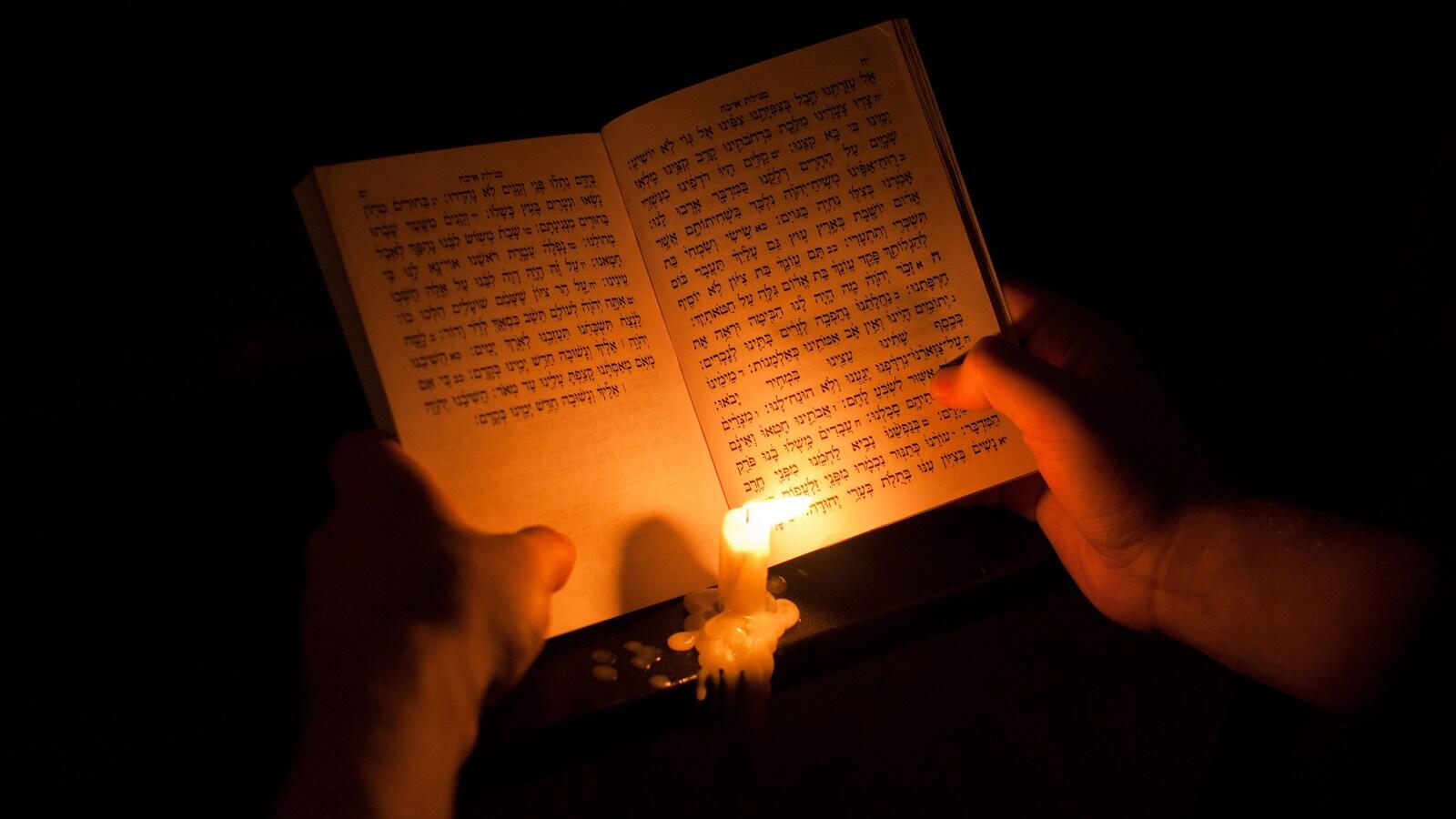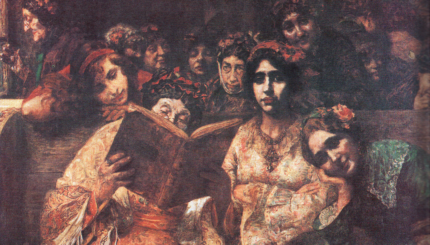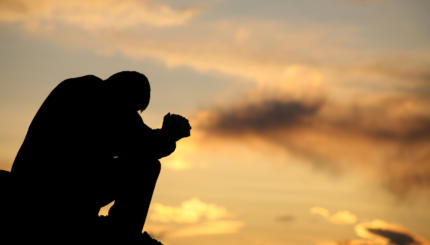The book of Eicha, traditionally ascribed to the prophet Jeremiah, describes in horrific detail the siege and destruction of Jerusalem by the Babylonian army in 586 BCE. It is customarily chanted in synagogues on the evening of Tisha B’Av, the ninth day of the Jewish month of Av. Normally, biblical readings are performed by a soloist standing in front of the congregation, but the reader of Eicha is seated like a mourner on the floor or a low bench.
Traditionally, biblical readings are not read with the spoken voice, but are chanted by a soloist in speech-like rhythms using a set of traditional motifs called cantillation (in Hebrew: ta’amey ha-mikra; in Yiddish: trop). In most Ashkenazi traditions there are six different cantillation modes, one of which is assigned for chanting Eicha. It is mournful music. Each verse begins in a major mode and ends in its relative minor mode.
Four of the five chapters of Eicha comprise 22 verses, and three of those are arranged as alphabetical acrostics, which means the first verse of the chapter begins with the letter Aleph (the first letter of the Hebrew alphabet), the second begins with Bet, and so forth until the final verse, which begins with the letter Tav (the last letter of the Hebrew alphabet). The third chapter is made up of 66 short verses (a triple alphabetical acrostic), and is given a special haunting melody. (You can listen to both modes of chanting here: https://www.chantingthehebrewbible.com/blank-idolw)
The Ashkenazi melody for chanting Eicha is heard in its entirety only once a year, on Tisha B’Av. But it has become a musical symbol of sorrow, powerfully evocative for those who recognize it in other contexts. On the Shabbat before Tisha B’Av, the melody is used to herald the upcoming day of mourning. One verse from the Torah portion read that day (Deuteronomy 1:12), which begins with the word Eicha, is chanted using the mournful Eicha motifs. And most of the verses of that Shabbat’s haftarah are likewise chanted in the Eicha mode. On Tisha B’Av itself, the haftarah of the morning service is chanted almost completely in that mode rather than the usual haftarah melody.

Help us keep Jewish knowledge accessible to millions of people around the world.
Your donation to My Jewish Learning fuels endless journeys of Jewish discovery. With your help, My Jewish Learning can continue to provide nonstop opportunities for learning, connection and growth.
Interestingly, the Eicha motifs are also heard on the merriest day of the Jewish calendar: Purim. Despite the festive mood of the day, verses from the Book of Esther that speak of threats to the Jews are sung in the Eicha style. These include Esther 8:6 (“How can I bear to see the disaster that will befall my people!”) and the allusion to the then-recent Babylonian catastrophe itself in Esther 2:6 (“[Mordecai] who, along with King Jeconiah of Judah, had been driven into exile by King Nebuchadnezzar of Babylon.”).
Eicha motifs can also be found in the world of classical music. In 1939, shortly after his graduation from Harvard, Leonard Bernstein wrote a song for voice and piano called, “Lamentation.” Three years later that song was adapted to become the third movement of Bernstein’s first symphony, which he called the Jeremiah Symphony. Composed in 1942, it reflected the composer’s anguish about the disaster that was befalling the Jews of Europe. Bernstein’s lamentation utilizes verses from the book of Eicha sung by a mezzo soprano soloist against a lush orchestral background. In the words of the composer, “It is the cry of Jeremiah, as he mourns his beloved Jerusalem, ruined, pillaged and dishonored after his desperate efforts to save it.” Bernstein also acknowledged that the mezzo soprano’s melody is based on the Eicha chant. “[The] opening phrase of the vocal part in the Lamentation is based on a liturgical cadence still sung today in commemoration of the destruction of Jerusalem by Babylon.”
Bernstein isn’t the only composer to have set Eicha to music. Many church composers were attracted to the expressive possibilities of the text. The 16th century English composer Thomas Tallis (no connection to the prayer shawl) used it as inspiration for his Lamentations of Jeremiah, loosely based on a Gregorian chant. In the Latin translation of Eicha, each letter of the alphabetical acrostic is inserted before each line of text, and the name of the letter is actually sung.
While most of Eicha is mournful in nature, one verse has made its way into the Jewish liturgy and has become familiar in several congregational melodies. The words from chapter 5 verse 21 — Hashiveynu Adonai eylecha venashuva, chadeysh yameynu kekedem (“Take us back, Adonai, and let us return; renew our days as of old.”) — are sung during the Sabbath and holiday services as the Torah is being returned to the ark. One of the most popular melodies was composed by Tanchum Portnoy and has become a popular congregational melody in many synagogues around the world.
The notation symbols that we use for chanting Eicha are only about 1,000 years old, but the practice of chanting can be traced back more than a millennium before that. Most likely, the words of this scroll were never spoken; they were always chanted. We don’t know exactly how old our melodies are; they didn’t appear in staff notation until about 200 years ago. But there is evidence that through the years Jews made every effort to protect these sacred melodies from change. And of course we are dealing with just one Ashkenazic tradition from Eastern Europe. Other communities maintained their own musical traditions, each one slightly different from the other, each carrying on its own version of an ancient Jewish tradition.



